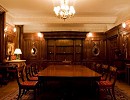Antiques for Sale | Antique Furniture | Antique Fairs | Antiques Listings | Antiques Email Alerts | Websites for Antique Dealers | Contact

The Antique Furniture Company
Tel : 01337 920027. Mob: 07838579323
Email : info@theantiquefurniturecompany.com
Web : www.antiques-atlas.com/theantiquefurniturecompany/
Private dealer
By appointment only
Cupar, Fife, Scotland
Viewing by prior appointment only.
Gillows George III Mahogany Secretaire Press


Description
A George III mahogany and inlaid low secretaire press cupboard attributed to Gillows of Lancaster and London and dating to circa 1790. With a rectangular top over a concealed long drawer with sloping front, mahogany crossbanding and parquetry and box stringing which continues across the top of the sides, the two long false drawer fronts below forming a deep secretaire drawer containing a writing slide with a hinged, ratcheted green baize inset slope above a central well flanked by six crossbanded and boxwood strung lidded and alphabetically ordered compartments, each inlaid with an oval panel engraved with four letters of the alphabet, and concealing secret recesses with drawers and original green fabric pulls.The pair of flame mahogany crossbanded and rope twist inlaid panelled doors below opening to reveal three sliding trays and all raised on ogee shaped bracket feet with weight bearing blocks behind. Original brass swan neck handles, locks and door catches. Marks and chips consistent with age and regular use and some old restorations, including dark marks to the top surface and chips to the back edge, replacements to the cockbeading and some losses which we can replace, one tray a period replacement in oak.
Please feel free to request more photos as we are limited in the number we can upload.
The overall dimensions at the largest points are approximately
Width - 48 5/8in (123.5cm)
Depth - 24 1/4in (61.5cm)
Height - 41 7/8in (106.3cm)
Writing slide
43 3/8in wide x 21 3/4in deep x 34 1/2in high (110.2cm x 55.2cm x 87.7cm)
Ref: 0690
Gillows of Lancaster were a leading manufacturer of furniture during the 18th and 19th centuries established around 1730 by a cabinet maker named Robert Gillow (I) (1703-1772). Robert was known for his use of mahogany which he imported from the West Indies and within a few years his workshop was being recognised for its superior quality of construction and use of desirable mahogany becoming one of the largest furniture producers outside London. He established the firm’s first links with London and the gentry, and sent his eldest son Richard (1733-1811) to be apprenticed to a ‘Mr. Jones’ of London, probably the architect William Jones. The London Oxford Street shop was established in 1769-70. New workshops were built in both Lancaster and London and furniture ordered in London was sent every week from Lancaster. Importantly, from the mid-1750s, Richard, working in Lancaster, could draw fashionable new furniture based on designs sent to him by his cousin James, a journeyman in London. When Robert Gillow died in 1772, the business passed to his two sons, Richard and Robert. While Robert managed the London branch, and was thereby familiar with all the latest London fashions, Richard ran the Lancashire base. It was between 1750 and 1811 that some of the best English furniture ever was being fabricated by the Gillow company in Lancaster.
Architect’s desks and chests with secretaire drawer appeared in the Gillows Estimate Sketch Books at the very end of the 18th and very beginning of the 19th centuries in various forms, including those with rising ratchetted tops. One notably refined recurring feature considered a hallmark of Gillows design is the secretaire with upper sliding writing slope and the lower half fitted with an arrangement of six hinged lidded compartments inlaid with an ovals engraved with four letters of the alphabet. Secret or ‘private’ drawer, as Gillows called them, with green material pulls were concealed at the back of these compartments. The designs and drawings for secretaire library cabinets in the Gillows Archives include ‘Lettering the covers in the writing drawer’. Many cabinets, ‘buro’ writing tables, desks and bookcases from the 1780s and 1790s appear in these ledgers and numerous illustrated examples with a secretaire drawer includes the words about the alphabetically inlaid covers & green fabric.
Please appreciate all our items are antique and as such may have minor scratches, marks, knocks, shrinkage splits signs of old woodworm, and minor losses to veneer, which combine with care and years of polishing to create an individual character and patina. We cannot describe each marks separately and therefore suggest you do take the time to request extra photos. We do offer a 14 day money back guarantee for UK purchases but cannot refund the return shipping cost.
DateLate 18th Century :
Circa 1790
Codeas281a450 / 0690
Price £4500.00  €5269.50
€5269.50  $5752.80
$5752.80  The price has been listed in British Pounds.
The price has been listed in British Pounds.
Conversion rates as of 12/MAR/2024.
Euro & Dollar prices will vary and should only be used as a guide.
Always confirm final price with dealer. Delivery can be arranged, please contact us with a postcode for a price. StatusFor Sale
SellerThe Antique Furniture Company
Telephone01337 920027Non UK callers :+44 1337 920027 Emailinfo@theantiquefurniturecompany.com
StatusFor Sale
SellerThe Antique Furniture Company
Telephone01337 920027Non UK callers :+44 1337 920027 Emailinfo@theantiquefurniturecompany.com
 €5269.50
€5269.50  $5752.80
$5752.80  The price has been listed in British Pounds.
The price has been listed in British Pounds.Conversion rates as of 12/MAR/2024.
Euro & Dollar prices will vary and should only be used as a guide.
Always confirm final price with dealer. Delivery can be arranged, please contact us with a postcode for a price.
 StatusFor Sale
SellerThe Antique Furniture Company
Telephone01337 920027Non UK callers :+44 1337 920027 Emailinfo@theantiquefurniturecompany.com
StatusFor Sale
SellerThe Antique Furniture Company
Telephone01337 920027Non UK callers :+44 1337 920027 Emailinfo@theantiquefurniturecompany.com
Contact
Send The Antique Furniture Company a message about this item here





